
the central bay (“mandraki,” Gr. a little croft) of the port is located in the eastern part of the island, along the rebuilt promenade (destroyed in 2017 due to a strong earthquake). In the evenings, it attracts tourists. Pirate boats organize various sea excursions to nearby islands. There’s also a dock where you can take a boat to Turkey from.

a 14th-century fortress located between the urban port and the passenger and cargo port (network of connections Pireus-Kos-Rhodes), built by the Knights of the Order of St. John (nowadays the Knights of Malta) after settling on the island at the beginning of the 14th century. Free admission, open from Wednesday to Monday. Last entry at 3:00 PM.

located right next to the bridge thad leads directrly to the main gate of Neratzi Castle. According to the legend the tree is the birthplace of modern medicine, or the point where Hippocrates opened the world’s first medical academy two and a half thousand years ago.
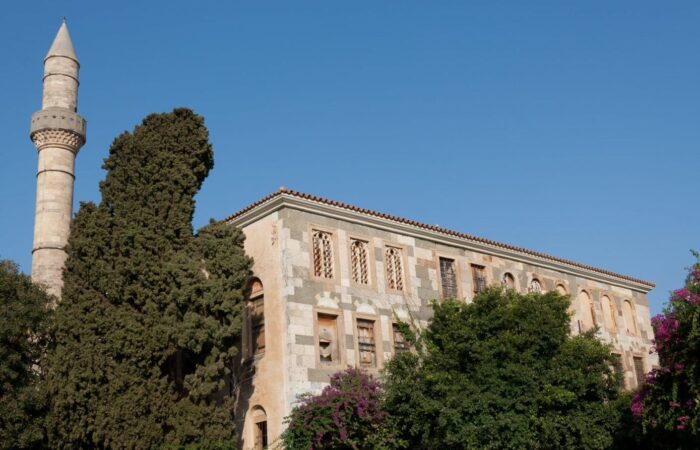
the largest and youngest of the 5 mosques that operated in the city of Kos, built at the end of the 18th century, currently under renovation after damage caused by the 2017 earthquake.

built in the 1920s by the Italians occupying the Dodecanese, served as both the residence of the local governor and the administrative center of the city and the island.
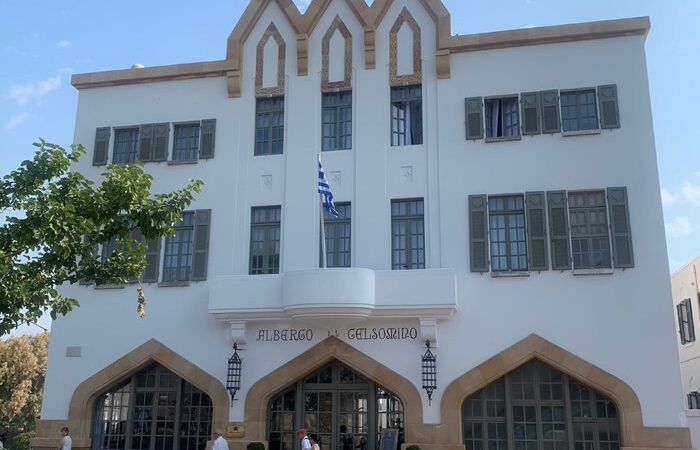
the first hotel on the island built in the 1920s. From 2017 to 2019 under a major renovation and it is currently one of the most expensive and luxurious hotels in the town.

discovered in the 1930s, one of the most important remnants of the ancient world of the island of Kos. Here are the remains of the temples of the goddess Aphrodite, Heracles, the stoa, nymphaeum and more. Well-preserved mosaics are also visible. The most parts of ancient buildings are visible within the walls of Neratzi Castle. Some of them were moved to Rhodes and can be spotted in the exhibition parts of the Palace of the Grand Masters.

a central square that is a meeting place for residents and local cultural events. Around it, there are many cafes, ice cream parlors, and gastronomic places.

built in the 18th century directly on Freedom Square, was a representative place for the city – the characteristic minaret towering over Eleftherias Square was destroyed in 2017 together with the foot washing spot. The mosque itself, due to damage, ceased to be used for liturgical, gastronomic (there were two very popular cafes here), and commercial (jewelry stores) purposes.

a massive building with a clock tower, which served as an entertainment venue for the Italian aristocracy living on the island – to this day, there is a small Orpheus Cinema here. In addition to the cinema, Italians visited this place to eat, drink, or dance. There was also a casino here.

a public market that has existed in this place since the beginng of the city’s timeline. Local products (wine, olive oil, meat, honey, handicrafts, etc.) were traded here, and to this day, many of them can still be purchased here for small amounts of money.

a part of the city of Kos, which stretches along Dodekanisou Street (pedestrian only) and is a place with a lot of shops, cafes, and taverns. You can shop here, drink iced coffee, or eat something. The street runs from Freedom Square, crosses Venizelou Street, and ends at Diagoras Square, where you can find very good taverns and a small minaret of the destroyed mosque.

built in the 1930s, it contains a 3-level museum exhibition from prehistoric times through the Hellenistic, classical, medieval, and Byzantine periods. Open from Wednesday to Monday, ticket price 6 Euro.

a well-preserved small Roman auditorium, below which there is a small museum. Open every day, free admission.
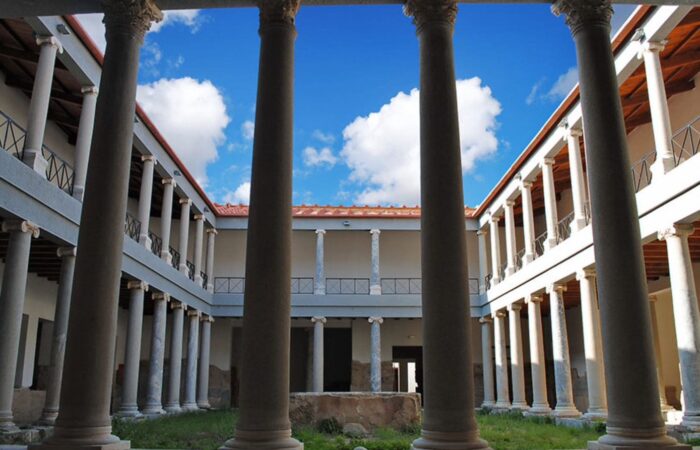
a fine reconstruction of one of the many villa houses built in the luxurious part of the ancient city of Kos by the Romans. The two-level museum provides access to all rooms with a rich display of artifacts. Open from Wednesday to Monday, admission 6 Euros.

a Christian church with characteristic blue domes, which underwent renovation from 2020 to 2023 after the damage it suffered in 2017.

a settlement directly west of the city of Kos, inhabited by about 3,500 Muslims. There is an abandoned Jewish cemetery and two Muslim cemeteries here. The only currently operating mosque (Gazi Hassan Pasha) is located in the village, which contains an unusual mosaic on which the entire Quran is written in extremely small print. In the center of the village is a small square and several local taverns serving unique cuisine combining Turkish and Greek flavors.

located on the east side of the island, where you can taste the health-promoting hot bath in sulfur water. This water gushes from the source straight into a small bathing area right by the sea and is closely related to the active (although dormant) Nisyros volcano south of Kos.

one of the most important monastic centers on the island.

an ancient center of worship of the god of the medical arts – Asclepius. It was a revolutionary temple-resort center that attracted patients from all over the ancient world (including Rome and Egypt). Its remains, discovered in the early 20th century, will come to life before your eyes once you’re there.
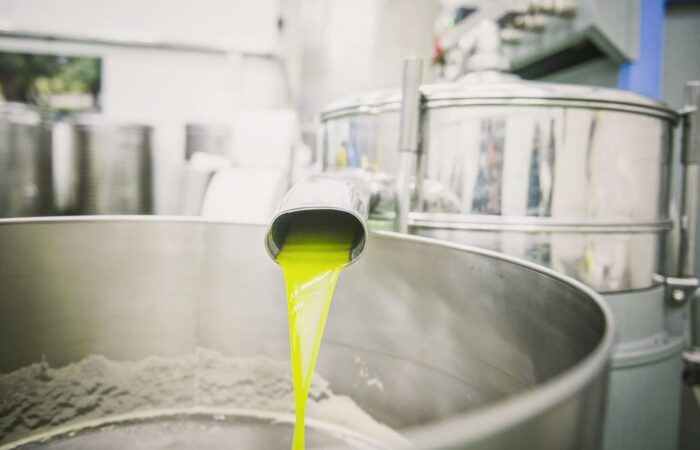
there is relatively small (but sufficient) olive oil production on the island. Each press offers tastings of its products and the opportunity to purchase them.

wine production has been like breathing for Greeks for thousands of years – necessary for life. From selected grape varieties, wine is produced, which absorbs the same benefits of the Kos soil from antiquity.

an abandoned settlement in the mountainous part of the island. There is a very atmospheric café ” Haihoutes” where you can taste Greek coffee brewed in a traditional way.

a very popular mountain village offering numerous gastronomic places with beautiful views and many tourist shops offering local products and souvenirs. Especially popular in the evenings for sunset observation, but it is a very commercialized place and often crowded, thus losing its charm. It is worth visiting the 11th-century church with a 1000-year-old wooden iconostasis.
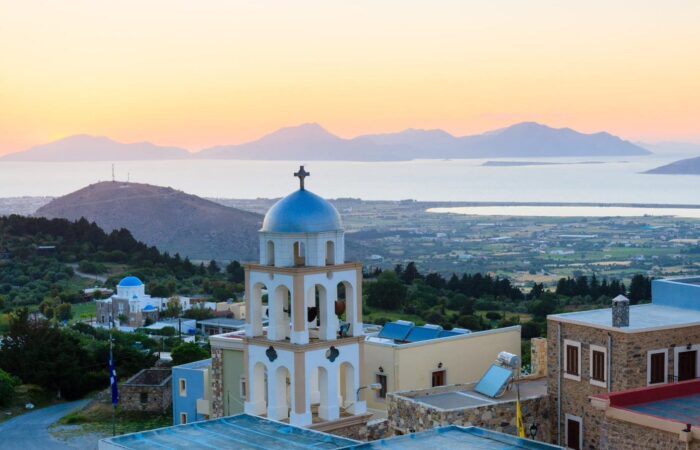
a small village near Evangelistria, which is much less (or not at all) commercialized. Traditional Aegean architecture (white houses with blue shutters and narrow streets) is located right here. It is worth to visitghe church of Agji Asomati (literally “holy without bodies”) from the 11th century.

an abandoned in the 19th century settlement , where the ruins of buildings and the fortress of the same name have been preserved. A beautiful view of the northern part of the island will be an alternative to sunset observation for many of you.

situated below, it was the place where the inhabitants of Palio Pyli village settled (reason: cholera epidemic, distance from farmland, significant decrease in pirate activity). The village’s architecture mainly consists of traditional stone houses. In the central square, there are several places where you can enjoy traditional coffee or eat traditional Greek delicacies. A little further away is a source of drinking water in the form of a fountain with lion heads and the grave of Harmylos – a local king.

an abandoned sea salt extraction plant (operated until the 1930s during the Italian occupation). Currently not used for this purpose. It serves as a stopover and feeding ground for migratory birds (storks, cranes, pelicans, and flamingos).

a characteristic hill in the shape of a mound at the height of Tigaki and Linopotis villages. At the top is a small church of Prophet Elias. For many, it will be an interesting alternative for watching sunsets.
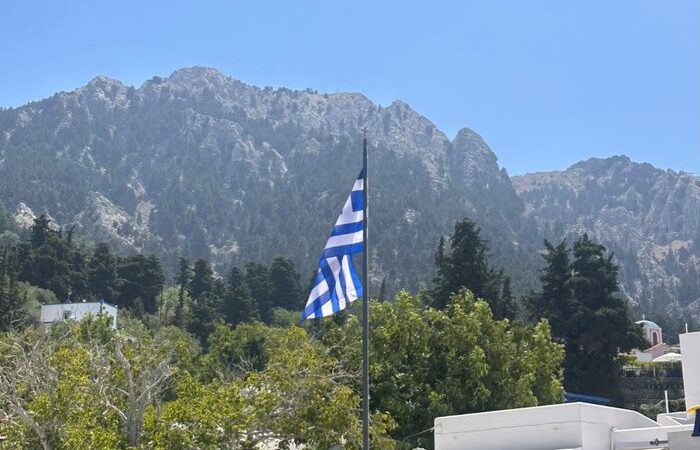
a mountain range located in the southern part of the island, the highest peak – Dikeos – rises to a height of 846 meters above sea level, and there is a hiking trail from Zia village to it. At the top, there is a small monastery of Pantokrator (you can even stay overnight), a cross, and a magnificent view of the sunset and sunrise.

built at the end of the 14th century as a prison, later transformed into a defensive building, which, using the terrain, was never taken over as a result of a siege. Panoramic view of the southern side of the island – with good visibility, you can easily spot the island of Rhodes.

located directly near the airport village characterized by traditional architecture (stone houses, painted white, blue shutters). Here is the oldest and only functioning windmill in Greece (a building in the style of Naxos) – they still grind flour from which they produce local cookies and other pastries or pasta (entrance 2 Euro). Next to the windmill is an ethnographic museum presenting the interior of a Greek rural house and traditional Antimachia folk costumes (entrance 2 Euro).

a recently opened complex of reconstructed stone buildings, run by a Cretan volunteer actively involved in the migration crisis. You can stroll around the area and gardens, drink delicate herbal tea, buy 100% natural local products – just like in the original Hippocrates garden, here you can discover herbs used in medicine for hundreds of years.

there are several commercial honey producers on the island, one can be visited during the journey to Kefalos. The Anthoulis family has been producing honey for over 100 years, producing about 8-9 tons of honey annually. The main types are: thyme, heather, pine, and multifloral. In addition to honey and products based on it, you can find many natural cosmetics, drink coffee in the local café.

a series of sandy beaches stretching from Mastichari to Lambi. They are considered the most beautiful beaches and are popular among local residents and tourists.

beaches stretching along a 4-kilometer sandy coast between Kardamena and Kefalos. They attract many people so they are not intimate places. In summer, the water is always flat or gently waving due to the constant, summer wind direction.

beaches that are considered the best for kite surfing. There is a kite surfing school on Kochylari beach. In summer, you can find loggerhead sea turtle nests here, but they are not marked or protected in any way. Sunbathing in their vicinity is not allowed.

ruins of an early Christian basilica of Saint Stephen (discovered in the 20th century) and partially rebuilt. The spot is in a charming location directly on the coastline.
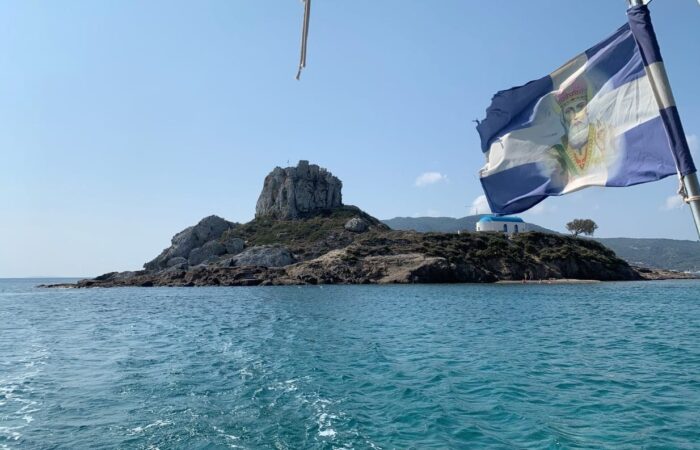
a distinctive islet located in Kefalos Bay. It has been an island since 411 BC when a strong earthquake submerged the then capital of Kos, Astypalia, and detached the island from the mainland. On the islet stands a small chapel-church of St. Nicholas, which is often chosen for wedding ceremonies. The island is 175 meters away from the shore – you can swim to the islet, rent a pedalo, or use the services of a local boat captain. It is a natural habitat for seagulls and cormorants.

a bay formed about 150,000 years ago as a result of a volcanic eruption (the last one on the island of Kos) and until 411 BC, the largest settlement – Astypalia was located here. It was completely submerged due to an earthquake. The water is crystal clear, although it is considered the coldest on the island. Rocky formations above the water and hidden beaches are often only accessible from sea level.

a hilltop village with a beautiful view of Kefalos Bay and the central-lowland part of the island. The ruins of the fortress are particularly noteworthy – a viewpoint consisting of the remnants of a fortress rebuilt in the Byzantine period, and later by the Knights Hospitaller.

on the characteristic “tail” of the island, there are several beaches that attract tourists. Some can be reached by asphalt road, others by dirt road (note! When driving a car, make sure that insurance also covers dirt roads!) In many cases, beaches do not have sanitary facilities. A very good vantage point for sunset observers.
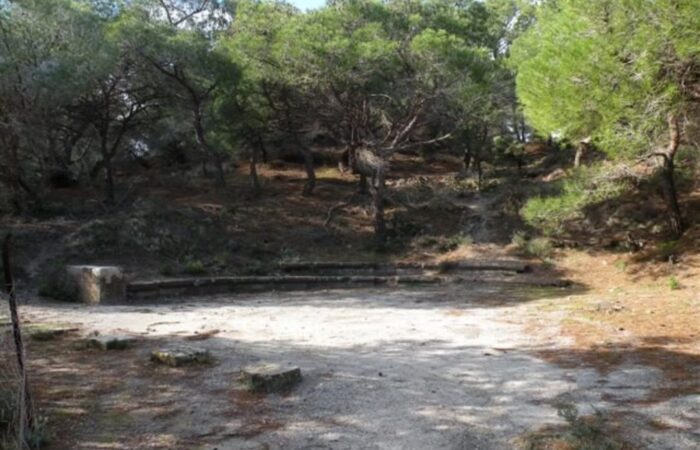
poorly preserved ruins of an ancient theater, probably destroyed in 411 BC.

a rock formation distinguished by its color. Located high above Kefalos Bay, it creates a very interesting viewpoint. Next to it is a cave that provided shelter for people as early as the Neolithic. You can partially reach it by asphalt road, then about 2km of gravel road.

a popular place to drink coffee in a quiet area near a small monastic complex.